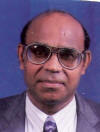|
| |
 |
Reflections-By
Dr Rajan Philips
The black box
( This
motivational article was published in Oman Observer ,
one of the leading Newspapers in Oman. The article is
reproduced with the permission of the author )
|
| |
Dr.Rajan Philips:
Air travel is a wonderful gift of modern science and technology that has
contributed significantly to shrink our world into a global village.
But every now and then major and fatal air crashes snuff out hundreds of lives
and create shock waves. The air crash near Islamabad, Pakistan in which over 150
lost their lives is the most recent instance. The graphic media coverage of such
mishaps heightens the impact of the tragedy.
When such unfortunate events occur accident investigators hunt for one vital
piece of equipment with a great sense of urgency — the black box or in technical
jargon, the flight data recorder (FDR). A brief look at the origin and
development of this indispensable and mandatory device on all planes will be
apt.
Many scientists contributed to the development of the ‘black box’ as we know it
today. Yet, if one person can be singled out for special acclaim, it is Dr David
Warren, a chemist who specialised in aircraft fuels.
A series of fatal accidents in 1953 and 1954 involving the De Havilland Comet
jet airliners prompted an intense investigation by a professional committee that
had Dr Warren as a member. Lack of reliable data hampered them.
Dr Warren then came up with the original concept of the need for a crash-proof
method to record the flight crew’s conversation and other data in order to
determine the causes of such accidents and help prevent future, similar
avoidable mishaps.
He led a team of aviation engineers at the Aeronautical Research Laboratories in
Melbourne to produce the first prototype of such a device in 1956. But oddly,
aviation authorities worldwide failed to see its utility and remained lukewarm.
Pilots perceived it as a “Big Brother” spying on their actions.
But things did change. With more air disasters, the aviation industry had to
acknowledge the value of Warren’s invention. Australia became, in 1960, the
first country in the world to make the use of ‘black boxes’ mandatory. On modern
day aircraft there are two “black boxes”. One is the Cockpit Voice Recorder (CVR)
that records cockpit and pilot to controller communications. The other is the
Digital Flight Data Recorder (DFDR) that records flight control inputs and
parameters like speed and altitude.
The origin of the popular term “Black Box” may have something to do with the
early film-based design of flight data recorders, which required the interior of
the recorder to be perfectly dark. The name, though, is a misnomer in that
modern FDRs are externally painted red or bright orange for high visibility at a
crash site. They are usually mounted in the aircraft’s tail section where the
impact of crash is likely to be minimal.
Black boxes are carefully engineered and stoutly constructed using very strong
corrosion-resistant stainless steel or titanium capable of withstanding a high
speed impact and the heat of an intense fire. In fact, one manufacturing test
involves firing them from cannon into a wall to simulate an aircraft crash
scenario. It is not surprising that these devices cost between $10,000 and
$15,000 each.
While the search for the black box of a crashed plane may be an unpleasant and
chilling task, it is an inevitable aspect of the investigation. In fact, the
recovery of the device is second in importance only to the rescue of survivors
and recovery of bodies of victims.
The invention of the ‘black box’ is a key milestone in aviation history. That is
why the primary pioneer David Warren, who died recently, on July 19, at the age
of 85, deserves to be remembered with gratitude.
- Oman Observer
http://main.omanobserver.om
| |
|



